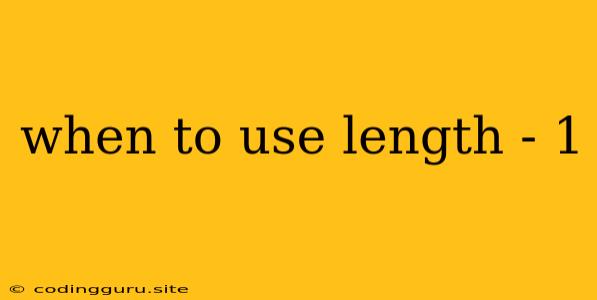When to Use "length - 1" in Programming: A Guide to Array Indexing
In the realm of programming, especially when working with arrays, you'll often encounter the expression "length - 1". This seemingly simple subtraction plays a crucial role in array indexing, and understanding its purpose is essential for writing accurate and efficient code.
Why is "length - 1" so Common?
Arrays in most programming languages are zero-indexed. This means that the first element in an array is located at index 0, the second element at index 1, and so on. The last element, however, occupies the index that is one less than the total number of elements in the array. This is where "length - 1" comes into play.
Example:
Imagine an array named numbers containing the following values: [1, 2, 3, 4].
- The length of this array is 4.
- The index of the first element (1) is 0.
- The index of the last element (4) is 3 (length - 1 = 4 - 1 = 3).
Common Scenarios for Using "length - 1"
Here are some common scenarios where using "length - 1" is essential:
1. Iterating through an Array:
When iterating through an array using a loop, you often need to access each element, including the last one. Using "length - 1" ensures that you don't try to access an element that doesn't exist, causing an IndexOutOfRangeException error.
Example (JavaScript):
const numbers = [1, 2, 3, 4];
for (let i = 0; i < numbers.length; i++) {
console.log(numbers[i]); // Access each element
}
// Output:
// 1
// 2
// 3
// 4
for (let i = 0; i <= numbers.length - 1; i++) {
console.log(numbers[i]); // Access each element
}
// Output:
// 1
// 2
// 3
// 4
2. Accessing the Last Element:
Directly accessing the last element of an array requires knowing its index. Using "length - 1" provides a reliable way to determine this index.
Example (Python):
numbers = [1, 2, 3, 4]
last_element = numbers[len(numbers) - 1]
print(last_element) # Output: 4
3. Working with Subarrays:
When extracting a subarray from a larger array, you might use "length - 1" to define the ending index of the subarray.
Example (Java):
int[] numbers = {1, 2, 3, 4, 5};
int[] subArray = Arrays.copyOfRange(numbers, 2, numbers.length - 1); // Extract elements from index 2 to 3 (length - 1)
System.out.println(Arrays.toString(subArray)); // Output: [3, 4]
Conclusion
The expression "length - 1" plays a pivotal role in array manipulation by accurately addressing the last element in a zero-indexed array. It helps prevent indexing errors and facilitates efficient iteration and subarray operations. Mastering this concept is crucial for any programmer working with arrays.
